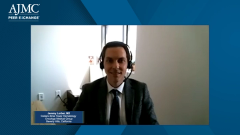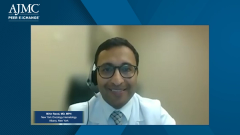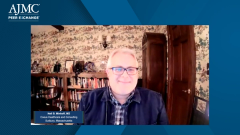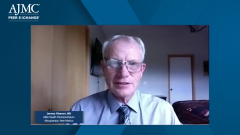
Novel Complement Therapies for Cold Agglutinin Disease
During a discussion on the next frontier of medicine for cold agglutinin disease, stakeholders react to the rationale for studying newer, novel complement-targeted therapies.
Episodes in this series

Neil Minkoff, MD: Let me turn back to our clinical discussion for a minute here, which is, my understanding is that there’s a new wave potentially of therapeutic options in terms of anticomplement therapy. I was wondering if one of my colleagues here on the clinical side could start to tell us a little bit about what the future potentially holds in terms of the next frontier in therapy here.
Mihir Raval, MD, MPH: I think it is just looking at the disease with a different perspective. When you understand the disease, we know that cold agglutinin disease has IgM [immunoglobulin M] antibody, which attacks the red blood cell, and then that activates your complements, and that actually leads to extravascular hemolysis. Now, you have 2 separate targets that you can go after. One is the antibody production, which we just discussed how targeting that through chemoimmunotherapy we can lower the antibodies, and that can break the circle. Or how about if we target the complement? Now you’re not touching the antibody production, but you’re actually affecting the complement-mediated extravascular hemolysis by blocking those complements.
There are 2 agents that have been tried so far, one of them is called sutimlimab. This was a paper published by [Alexander] Roth, [MD,] and colleagues in the New England Journal of Medicine about trying this humanized monoclonal antibody that is targeting the C1s complement, and the outcome that they looked for was to see if the patient’s hemoglobin goes up by 2 g, or at least over 12 g. They used this in 24 individuals by using the sutimlimab, and 54% of patients did achieve that goal. Just by blocking 1 of the aspects of the disease, they did have more than half the patients achieve better control of their anemia. Having said that, now you are not affecting the actual antibody. That means you are not actually affecting the cold-induced symptoms. You are fixing the anemia, but the cold exposure-related symptoms that the patient might experience may still be there, and that is not affected by this.
The other thing is this is more for long-term treatment. What ends up happening is the moment you stop it, you remove that effect of complement inhibition, and the process can restart again. It’s an excellent idea, excellent treatment, we adopted that from a lot of other complement-mediated diseases. The other complication that can happen is actual infection. Just like we know from some of the other agents we use directed against complement in conditions like PNH [paroxysmal nocturnal hemoglobinuria], patients have to be vaccinated against meningitis, against haemophilus influenzae or streptococcal pneumonia, and they have to be revaccinated every few years because their risk of encapsulated bacterial infection goes high.
Another agent that has been tried is paxitacopan, which is blocking a different complement protein that blocks C3. They tried that in a variety of patients with autoimmune hemolytic anemia, and out of them, 2 patients had cold agglutinin disease, and they had a significant hemoglobin bump, 3 and 5.7 g, respectively. Now again, remember that cold agglutinin disease-related symptoms from cold exposure may not be addressed here, and also you have to consider using those treatments for long-term duration if you are just impacting the complement pathway. That is just a summary of some of those complement-directed treatments that are up and coming. It is exciting science-based treatment, but at the same time, we have to really learn about what it affects and what it doesn’t treat.
Neil Minkoff, MD: Let me ask you a quick question, which is how does the dosing of these compare to the medications we’ve talked about, which are reasonably short duration?
Mihir Raval, MD, MPH: In the study for sutimlimab, they actually used the medications on day 0, day 7, and then every 2 weeks after that. The study was designed for 26 weeks, so patients used that drug for a long term. And when they stopped it, I’m not sure if we have any data on the longer follow-up on what happened after that, if they continued the treatment. With some instances, they do, if the patient responds. But it is not a finite duration, so now you’re looking at more long-term duration of treatment, similar to other complement-mediated treatment where the treatment is not finite, it’s for long-term duration, until the patient stops responding.
Jeremy Lorber, MD: The study with sutimlimab did have an extension phase, so the patients who were deriving benefit were treated beyond the 26 weeks, and I think it’s presented maybe in abstract form, but there was ongoing duration of response. But to get to the point, it is an indefinite treatment. There’s no specified duration where patients can stop, at least based on how the study was designed and how it might be approved if the FDA eventually approves it.
Neil Minkoff, MD: Not to put you guys on the spot, and it’s totally OK to say, “We don’t have enough data yet” or whatever. But would this be something that you would have patients sort of step to if they’re having continued problems after episodic care? Or would there be a subset of patients who you’d be thinking this would be…an early based therapy?
Jeremy Lorber, MD: For me, most patients who would be candidates for the novel complement-targeting therapies would be patients who’ve already received bendamustine and rituximab, or who were not candidates for bendamustine and failed rituximab alone, mainly because of, again, the duration of treatment. Four months of therapy is more palatable for patients than ongoing treatment every 2 weeks. Furthermore, we don’t have any reason to think that sutimlimab is necessarily more effective than rituximab and bendamustine.
In the CARDINAL trial looking at sutimlimab, not all the patients had prior therapy, and among those who did have prior therapy, not all of them had rituximab with chemotherapy. These aren’t necessarily all refractory patients. Some patients may have done just as well or better with rituximab and chemotherapy and been able to have a long remission off of treatment. For me, generally, sutimlimab and other complement drugs would come after current treatments.
Transcript edited for clarity.
Newsletter
Stay ahead of policy, cost, and value—subscribe to AJMC for expert insights at the intersection of clinical care and health economics.































































